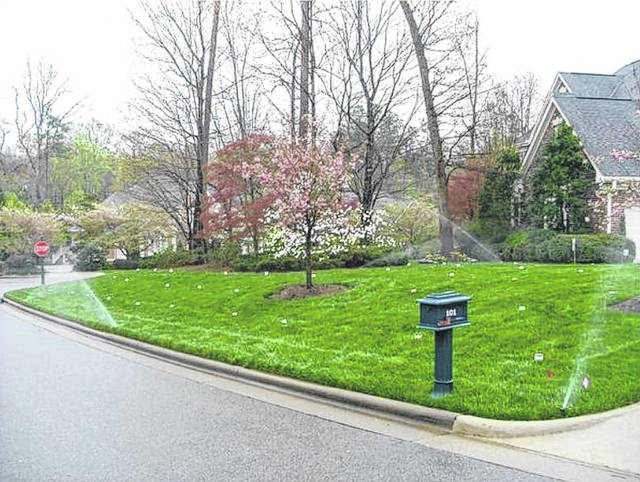
Photo curtesy of NC State University
Not sure how long to run your irrigation for an inch of water? Set out tuna or cat food cans throughout your lawn, to measure the output.
What a summer we’re having so far. Wait: It’s still technically spring, and we’re experiencing high temperatures and little rain, more similar to summer weather than spring. Plants are very confused with the yo-yoing of temperatures, long periods of rain followed by drought. And we’re just in May!
As I’m fond of saying, in the Sandhills we’re always four days away from a drought. It could rain every day for a week, but after four days in the summer with no rain, plants will be wilting and the sandy soil can be bone dry. An inch of rain (or irrigation) will provide the equivalent to approximately 600 gallons of water per 1000 square feet; most plants and turf need at least an inch of water per week in order to thrive. Soil types have varying “water holding capacities”: Sandy soil is able to hold around .75 to 1.25 inches of water per foot of soil, while clay soil can hold more than twice as much, up to 2.50 inches (with other soil types falling somewhere between). If it rains 2 inches, sandy soil is not able to hold all that rain, and some of it escapes and moves downward out of reach of plants. Not only can clay soil hold more water than sand, it can hold it for a longer period of time. So a two inch rainfall can be held in a clay soil longer, allowing plants to access water over time.
While it may be tempting to add clay to your sandy soil to get some of those benefits, that’s not a recommended practice (people have tried it, and it did not go well, ending up with something more akin to concrete than soil). However, here are some strategies that can help you have a landscape that can somewhat withstand the ravages of a Sandhills summer.
Number 1: plant your trees, shrubs, and perennials in the fall for improved establishment. Because plants don’t have to struggle as much to beat the heat in the fall, they are less stressed, and able to put more energy into developing a strong root system. The benefits of fall planting mean the plant is better able to cope with heat and drought by the time summer comes around.
Number 2: Mulch your trees, shrubs and perennials with pine bark, pine straw, or even fall leaves, keeping the soil covered. Soil temperature stays cooler, reducing plant stress; mulch helps slow water evaporation, preserving moisture longer. Mulch helps keep weeds suppressed, and will eventually break down, adding organic matter to the soil which will also help increase the soil’s water holding capacity in the long run.
Number 3: Water in the early morning or late afternoon. This reduces water loss through evaporation which occurs when watering during the heat of the day. It allows the plant to time to become well hydrated before it gets really hot. Realize that even a plant that has moisture in the soil may wilt during the hottest part of the day. Wilting can be a physiological defensive
mechanism, as wilting reduces leaf surface which reduces transpiration (movement of water out of the leaves), thus reducing water loss. If a plant is watered during the hottest part of the day when it is trying to conserve water through wilting, this can cause plant stress.
Number 4: When it comes to turfgrass, pick a strategy to address the drought situation and stick to it. Most warm season grasses such as centipede, zoysia and Bermudagrass go dormant to handle heat and drought stress. They will turn brown, but they won’t be dead. When the temperature drops and rain begins, they will green up again. Note that this is not a strategy for fescue, which can be killed under these conditions. On the other hand, you can irrigate your lawn, preferably three times a week for about an inch to an inch and a half of water total, if you want your lawn to stay green. If embarking on this strategy, you need to stick to it throughout the drought period. Watering sporadically, preventing the grass from going into dormancy to protect itself, but not providing enough to keep it growing, could cause your grass to struggle and even die.
Finally, keep a rain gauge in your yard, so you can keep track of rainfall to know how much irrigation you need to compensate for lack of rain. Rains in summer can be extremely sporadic, with one area receiving a deluge while the sky is blue a mile away.
For more help and answers to your landscape questions, give us a call at NC Cooperative Extension, Richmond County Center, at 910-997-8255. Follow us on facebook and visit our website, Richmond.ces.edu.
Paige Burns Clark is the horticulture agent and director of the Richmond County Cooperative Extension.
